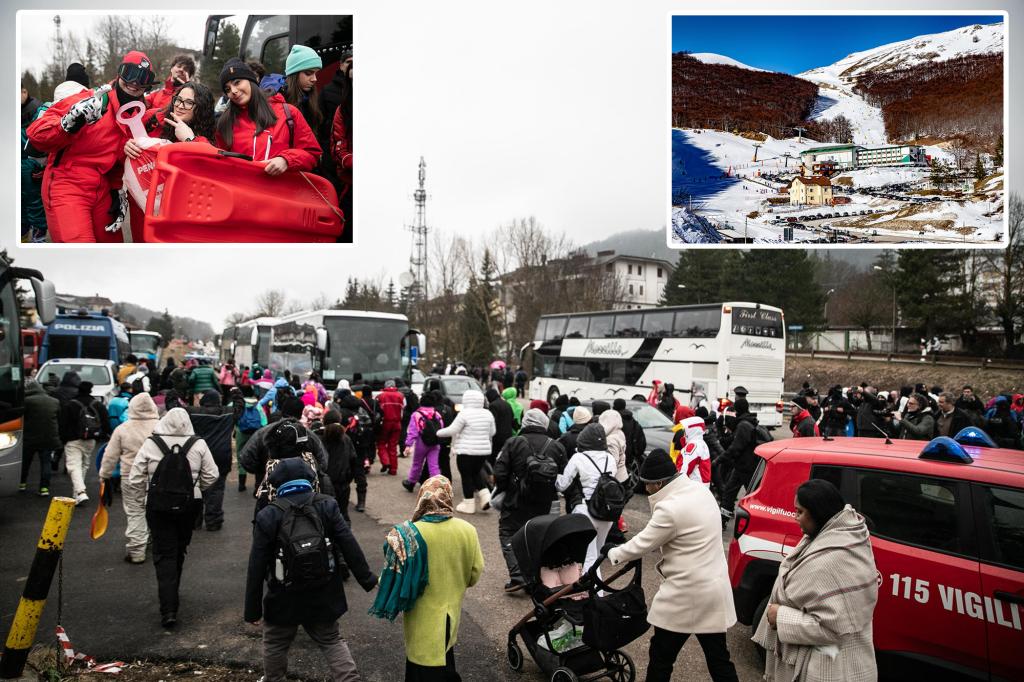The picturesque Italian ski resort of Roccaraso, nestled in the heart of the Abruzzo region, recently found itself grappling with an unprecedented influx of visitors, transforming the typically serene winter wonderland into a scene of chaos and congestion. This sudden surge in tourism was not a result of organic growth or traditional marketing campaigns, but rather the potent influence of social media, particularly the popular video-sharing platform TikTok. The allure of viral content, coupled with affordable tour packages, proved an irresistible draw for thousands of day-trippers, primarily from the bustling city of Naples, leading to a clash between the thrill-seeking newcomers and the established rhythm of the local community.
The catalyst for this unexpected wave of tourists can be traced back to the online activity of Rita De Crescenzo, a prominent Neapolitan influencer whose enthusiastic endorsements of Roccaraso’s snowy landscapes resonated with a vast audience. De Crescenzo’s videos, capturing the idyllic beauty of the snow-covered resort, sparked a frenzy of interest among her followers, prompting many to seek out their own winter escape. Tour operators, ever-attuned to emerging trends, seized upon this burgeoning demand, rapidly organizing budget-friendly bus trips to Roccaraso, promising a taste of alpine adventure at an accessible price. The confluence of influencer-driven excitement and readily available transportation converged to create a perfect storm of overtourism, overwhelming the resort’s infrastructure and testing the patience of its residents.
The sheer scale of the influx was staggering. Over 220 tour buses, each carrying dozens of eager visitors, descended upon the relatively small resort town, joining the hundreds of private vehicles already converging on the area. This sudden influx of 10,000 day-trippers, on top of the usual weekend crowd, pushed Roccaraso’s capacity to its limits. The narrow mountain roads, ill-equipped to handle such a volume of traffic, became choked with vehicles, trapping locals and seasoned skiers alike in hours-long gridlocks. Beyond the logistical challenges, the behavior of some visitors further exacerbated the situation, with reports emerging of disregard for ski etiquette, makeshift sledding contraptions crafted from everyday items like saucepans, and the careless discarding of trash, marring the pristine environment. The impromptu barbecues ignited by some visitors added another layer of concern, posing a potential fire hazard in the dry, alpine setting.
The situation rapidly deteriorated, prompting local authorities to implement emergency crowd control measures. Access for tour buses was restricted, aiming to stem the tide of day-trippers and restore some semblance of order to the overwhelmed resort. The mayor of Roccaraso, Francesco di Donato, described the influx as a “real assault” on the area, painting a vivid picture of the “hellish” conditions faced by residents and regular visitors. The frustration was palpable amongst locals, who felt their peaceful mountain retreat had been transformed into a chaotic carnival. The disruption extended beyond mere inconvenience, as long-time pass holders found themselves waiting hours to access slopes that were now overcrowded with inexperienced skiers, many of whom seemed more intent on capturing social media content than adhering to established ski norms.
While De Crescenzo defended her actions, claiming her videos were simply meant to showcase the beauty of Roccaraso, the fallout from her viral posts ignited a debate about the responsibility of influencers in managing the impact of their content. Accusations of promoting irresponsible tourism were leveled against her, while some visitors countered by alleging discriminatory treatment from locals based on their Neapolitan origins. The mayor, however, insisted that the issue was not one of prejudice but rather of capacity and respect for the environment. He emphasized the resort’s desire to welcome tourists but stressed the importance of responsible behavior and adherence to established rules.
The incident at Roccaraso serves as a stark reminder of the double-edged sword of social media influence. While platforms like TikTok can undoubtedly boost tourism and expose hidden gems to a wider audience, the potential for unintended consequences, such as overtourism and environmental degradation, cannot be ignored. The delicate balance between promoting attractive destinations and preserving their integrity requires careful consideration from both content creators and those who manage these spaces. The challenge lies in harnessing the power of social media to drive sustainable tourism, ensuring that the benefits are shared by both visitors and the communities they visit, fostering a harmonious coexistence rather than a disruptive invasion. Roccaraso’s experience offers a valuable lesson in navigating this complex landscape, underscoring the need for proactive planning and responsible engagement in the age of viral trends. The incident highlights the increasing necessity for destinations to anticipate and mitigate the potential impact of social media-driven tourism, implementing strategies that balance economic benefits with environmental protection and the well-being of local residents.


